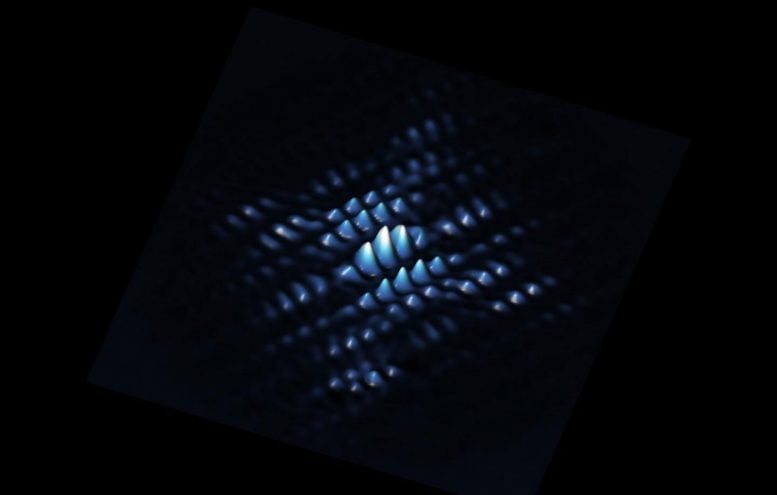
A scanning tunnelling microscope image showing the electron wave function of a qubit made from a phosphorus atom precisely positioned in silicon. Credit: UNSW
The unique Australian approach of creating quantum bits from precisely positioned individual atoms in silicon is reaping major rewards, with UNSW Sydney-led scientists showing for the first time that they can make two of these atom qubits “talk” to each other.
The team – led by UNSW Scientia Professor Michelle Simmons, Director of the Center of Excellence for Quantum Computation and Communication Technology, or CQC2T – is the only group in the world that has the ability to see the exact position of their qubits in the solid state.
Simmons’ team create the atom qubits by precisely positioning and encapsulating individual phosphorus atoms within a silicon chip. Information is stored on the quantum spin of a single phosphorus electron.
UNSW Sydney-led scientists have shown for the first time that they can make two precisely placed phosphorous atom qubits “talk” to each other.
The team’s latest advance – the first observation of controllable interactions between two of these qubits – is published in the journal Nature Communications. It follows two other recent breakthroughs using this unique approach to building a quantum computer.
By optimizing their nano-manufacturing process, Simmons’ team has also recently created quantum circuitry with the lowest recorded electrical noise of any semiconductor device.
And they have created an electron spin qubit with the longest lifetime ever reported in a nano-electric device – 30 seconds.
“The combined results from these three research papers confirm the extremely promising prospects for building multi-qubit systems using our atom qubits,” says Simmons.
2018 Australian of the Year inspired by Richard Feynman
Simmons, who was named 2018 Australian of the Year in January for her pioneering quantum computing research, says her team’s ground-breaking work is inspired by the late physicist Richard Feynman.
“Feynman said: ‘What I cannot create, I do not understand’. We are enacting that strategy systematically, from the ground up, atom by atom,” says Simmons.
“In placing our phosphorus atoms in the silicon to make a qubit, we have demonstrated that we can use a scanning probe to directly measure the atom’s wave function, which tells us its exact physical location in the chip. We are the only group in the world who can actually see where our qubits are.”
“Our competitive advantage is that we can put our high-quality qubit where we want it in the chip, see what we’ve made, and then measure how it behaves. We can add another qubit nearby and see how the two wave functions interact. And then we can start to generate replicas of the devices we have created,” she says.
For the new study, the team placed two qubits – one made of two phosphorus atoms and one made of a single phosphorus atom – 16 nanometers apart in a silicon chip.
“Using electrodes that were patterned onto the chip with similar precision techniques, we were able to control the interactions between these two neighboring qubits, so the quantum spins of their electrons became correlated,” says study lead co-author, Dr. Matthew Broome, formerly of UNSW and now at the University of Copenhagen.
“It was fascinating to watch. When the spin of one electron is pointing up, the other points down, and vice versa.
“This is a major milestone for the technology. These types of spin correlations are the precursor to the entangled states that are necessary for a quantum computer to function and carry out complex calculations,” he says.
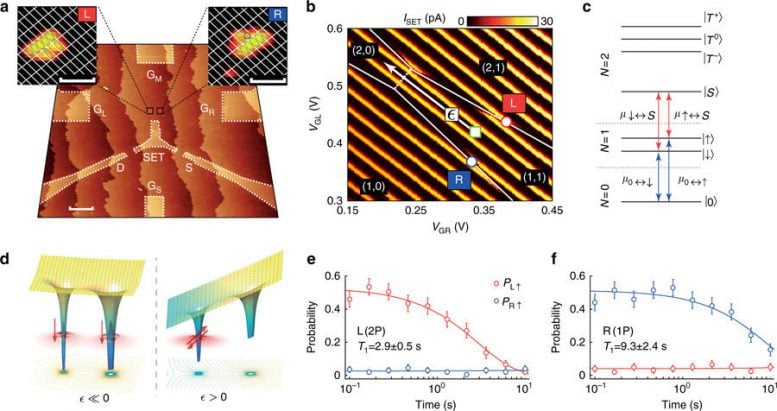
Two qubit 2P−1P device with independent sequential readout. a An STM micrograph of a precision placed two spin-qubit donor device showing the lighter colored lithographic outline where the hydrogen mask has been removed. Two spin-qubits, L and R, are separated by 16 ± 1 nm and sit equidistant at 19 ± 1 nm away from a larger readout structure which serves as both an electron reservoir and single-electron-transistor (SET) charge sensor with source (S) and drain (D) reservoirs and gates {GL, GM, GR, GS}; the scale bar is 20 nm. The insets show close-up STM micrographs of L and R where the green (blue) circles show fully (half) desorbed silicon dimers. White lines indicate the silicon dimer rows and the scale bars are 2 nm. b Current through the SET charge sensor as a function of VGL and VGR at the (1,1)–(2,0) charge transition. Electron spin readout is performed at the SET breaks (solid white lines, where tunneling of qubit electrons to or from SET can occur) at the red and blue circles for L and R respectively. The approximate wait position for spin relaxation measurements is shown by the green square and the detuning axis between (1,1)–(2,0), ϵϵ, is indicated by the white arrow. The dashed white line indicates where electrons can tunnel between qubit sites, i.e. where ϵϵ = 0. c The relevant electrochemical potentials in a magnetic field for spin readout of L (red arrows) and R (blue arrows). d A schematic representation of the controllable exchange interaction in a 2P−1P donor spin-qubit system. For detuning ϵ≪0ϵ≪0 the electrons are in the (1,1) charge configuration and the spins are independent. For ϵϵ > 0 the ground state (2,0) charge configuration is the two-electron singlet state. e, f Independent spin readout of L (R) demonstrated by spin relaxation, when the electron on R (L) is deterministically loaded with ∣↓⟩↓. In each case the qubit initially prepared as spin down shows no decay behavior indicating that the readout is independent at this detuning position, i.e. the exchange is negligible at the readout positions. All measurements were performed with Bz = 2.5 T. Credit: M. A. Broome, et al., Nature Communications, doi:10.1038/s41467-018-02982-x
Study lead co-author, UNSW’s Sam Gorman, says: “Theory had predicted the two qubits would need to be placed 20 nanometers apart to see this correlation effect. But we found it occurs at only 16 nanometers apart.
“In our quantum world, this is a very big difference,” he says. “It is also brilliant, as an experimentalist, to be challenging the theory.”
Leading the race to build a quantum computer in silicon
UNSW scientists and engineers at CQC2T are leading the world in the race to build a quantum computer in silicon. They are developing parallel patented approaches using single atom and quantum dot qubits.
“Our hope is that both approaches will work well. That would be terrific for Australia,” says Simmons.
The UNSW team have chosen to work in silicon because it is among the most stable and easily manufactured environments in which to host qubits, and its long history of use in the conventional computer industry means there is a vast body of knowledge about this material.
In 2012, Simmons’ team, who use scanning tunneling microscopes to position the individual phosphorus atoms in silicon and then molecular beam epitaxy to encapsulate them, created the world’s narrowest conducting wires, just four phosphorus atoms across and one atom high.
In a recent paper published in the journal Nano Letters, they used similar atomic scale control techniques to produce circuitry about 2-10 nanometers wide and showed it had the lowest recorded electrical noise of any semiconductor circuitry. This work was undertaken jointly with Saquib Shamim and Arindam Ghosh of the Indian Institute of Science.
“It’s widely accepted that electrical noise from the circuitry that controls the qubits will be a critical factor in limiting their performance,” says Simmons.
“Our results confirm that silicon is an optimal choice, because its use avoids the problem most other devices face of having a mix of different materials, including dielectrics and surface metals, that can be the source of, and amplify, electrical noise.
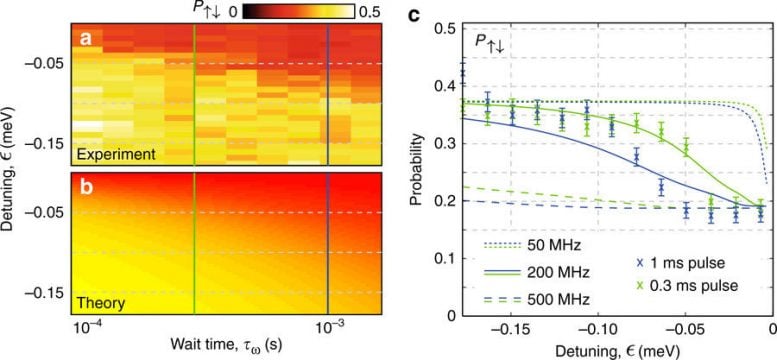
Experimental estimation of tunnel coupling. Starting with ρ↑↓, the measured probability P↑↓ (a) and the theoretical prediction (b) as a function of pulse wait time and detuning position. For the model we have used a value of tc = 200 MHz. cSolid green and blue curves show theoretical predictions for wait times of 0.3 and 1 ms respectively (corresponding cuts shown in a). Blue and green crosses show measurements for these wait times. The dashed and dotted lines show the theoretical predictions for tunnel coupling values of tc = 500 and 50 MHz respectively. Credit: M. A. Broome, et al., Nature Communications, doi:10.1038/s41467-018-02982-x
“With our precision approach we’ve achieved what we believe is the lowest electrical noise level possible for an electronic nano-device in silicon – three orders of magnitude lower than even using carbon nanotubes,” she says.
In another recent paper in Science Advances, Simmons’ team showed their precision qubits in silicon could be engineered so the electron spin had a record lifetime of 30 seconds – up to 16 times longer than previously reported. The first author, Dr Thomas Watson, was at UNSW undertaking his Ph.D. and is now at Delft University of Technology.
“This is a hot topic of research,” says Simmons. “The lifetime of the electron spin – before it starts to decay, for example, from spin up to spin down – is vital. The longer the lifetime, the longer we can store information in its quantum state.”
In the same paper, they showed that these long lifetimes allowed them to read out the electron spins of two qubits in sequence with an accuracy of 99.8 percent for each, which is the level required for practical error correction in a quantum processor.
Australia’s first quantum computing company
Instead of performing calculations one after another, like a conventional computer, a quantum computer would work in parallel and be able to look at all the possible outcomes at the same time. It would be able to solve problems in minutes that would otherwise take thousands of years.
Last year, Australia’s first quantum computing company – backed by a unique consortium of governments, industry, and universities – was established to commercialize CQC2T’s world-leading research.
Operating out of new laboratories at UNSW, Silicon Quantum Computing Pty Ltd has the target of producing a 10-qubit demonstration device in silicon by 2022, as the forerunner to a silicon-based quantum computer.
The Australian government has invested $26 million in the $83 million venture through its National Innovation and Science Agenda, with an additional $25 million coming from UNSW, $14 million from the Commonwealth Bank of Australia, $10 million from Telstra, and $8.7 million from the NSW Government.
It is estimated that industries comprising approximately 40% of Australia’s current economy could be significantly impacted by quantum computing. Possible applications include software design, machine learning, scheduling and logistical planning, financial analysis, stock market modeling, software and hardware verification, climate modeling, rapid drug design and testing, and early disease detection and prevention.
Reference: “Two-electron spin correlations in precision placed donors in silicon” by M. A. Broome, S. K. Gorman, M. G. House, S. J. Hile, J. G. Keizer, D. Keith, C. D. Hill, T. F. Watson, W. J. Baker, L. C. L. Hollenberg and M. Y. Simmons, 7 March 2018, Nature Communications.
DOI: 10.1038/s41467-018-02982-x

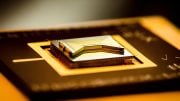



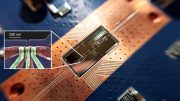
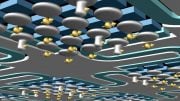
Supersymmetry | Wikipedia audio article
7:34+ 6:39
A quantum qubit is a comprehension unit of time-duality, phase-conic-dits.
Florence + The Machine – St Jude (The Odyssey – Chapter 3)
partis sets quanta podcast
… “Talk” if they talk at what speed is the communication conveyed?…
The Mandelbrot Set and Julia Sets
Scalings in the Mandelbrot Set
Hurwitz-Robucci scaling
time di-syphonons-tunnel across the vacuum
Google Images
time di-synchrony
Jeremy Soule (Skyrim) — All the Trees in Tamriel [3 Hr. Extension]